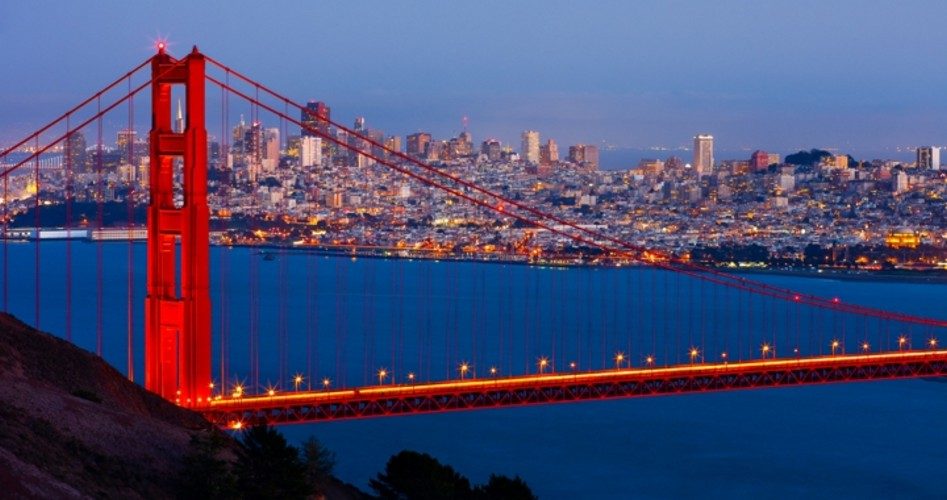
San Francisco is a city of contrasts. It boasts glorious views of the Golden Gate Bridge and the Pacific Ocean, and it also offers the stench and disgusting sight of piles of human feces on its sidewalks. It is a place filled with great wealth and striking poverty, with tech billionaires and Silicon Valley companies existing alongside an aggressive panhandling homeless population. While a city full of investors waits nervously on a new wave of initial public offerings (IPOs), drug users shoot up in the streets for anyone — be it tourists, businessmen, or schoolchildren — to see.
It is a place where the middle class is disappearing because housing prices have risen so high that average citizens simply cannot afford to live there. Sounds a lot like that income inequality the new “progressives” in Congress are always jabbering about. But San Francisco may be the most liberal city in America. So, what gives?
“We’re definitely at the boiling point, whether it’s the housing crisis, whether it’s the quality of life, which is exacerbated by the worst traffic congestion in America, or the affordability crisis,” said City Supervisor Aaron Peskin.
The housing crunch is about to get worse. The median home price in San Francisco is currently over $1.5 million, and with those new IPOs expected to hit soon, the housing market is in a nervous frenzy.
Realtor John Townsend explained, “You’re going to have a period of incredible demand not just from tech, by any means, but by [interest] rates being lowered in the last week.”
“The real problem is we can’t even remotely meet the demand,” Townsend concluded.
San Francisco-based companies Pinterest and Lyft recently went public, and Uber and Slack, also headquartered in the city, are expected to announce IPOs soon. Those IPOs will likely create dozens of new tech millionaires, and the worry is that those newly wealthy will scoop up all the available housing in the city.
Unnerved by the looming IPOs, families are buying homes as soon as they become available, often offering to pay above asking price. “[The IPOs] are in the back of people’s minds, and the people who have to buy are the ones going for it — the families that need houses, the double-incomes,” said realtor Monica Sagullo.
Polls have suggested that up to 53 percent of Bay Area residents are seriously considering leaving the area. The number one reason for that is the housing crisis.
Some numbers shine a bright spotlight on the situation. According to the Department of Housing and Urban Development, a family of four with an income of $117,000 per year is considered low income in the Bay Area counties of Marin, San Mateo and San Francisco. In San Francisco and San Mateo Counties, the California Association of Realtors estimates that prospective buyers would need a yearly income of $350,000 in order to buy a home.
The ratio of new jobs in the Bay Area to available housing stands at 3.5:1. The online real estate database Zillow estimates that a San Jose family of four with the median income of $118,000 would have to save up for more than 22 years for a 20-percent down payment on a median priced — $1.2 million — home in Silicon Valley.
Recently, a home that was listed as “Beyond FIXER, home is CONDEMNED, enter at your own RISK,” in the East Bay community of Fremont fetched a price of $1.23 million, well over its asking price of $1 million.
City Supervisor Matt Haney summed up the problem neatly: “It’s very hard for people who are not on the very high end of things, in terms of wealth, to feel like they can even make it in San Francisco, or own or commit over the long term to be here, and that creates a lot of anxiety.”
The desperation is palpable. Soon, you’ll have to be a millionaire to even live in San Francisco and a multi-millionaire if you wish to thrive in the city.
Or you can be homeless.
Today, the San Francisco Board of Supervisors is set to vote on a wedge issue in the city. During her campaign, Mayor London Breed promised voters she would create 1,000 new shelter beds for the homeless by the end of 2020. Toward that end, Breed is calling for a 200-bed “navigation center” for the homeless to be built in the swanky Embarcadero, a waterfront neighborhood along the eastern shore.
On any given night, San Francisco’s homeless population hovers around 4,500 people. The city began creating new navigation centers in 2015. The navigation centers differ from traditional shelters in that people can bring their pets and they are not kicked out come morning.
The Board of Supervisors is voting today about whether to lease the city a parking lot owned by the Port of San Francisco to build the new center. Residents of the area worry about their property values, crime, and potential impact on tourism. The Embarcadero is a waterfront area, popular with tourists, bicyclists, and joggers. To the north, the Embarcadero buts up against Fisherman’s Wharf, one of the biggest tourist destinations in the country.
Supporters of the waterfront center believe opponents are simply being heartless in not wanting a center among the high-end real estate and tourist destinations. Opponents believe they are being pragmatic and wonder why the navigation centers are not more evenly distributed around the city. They also believe that, rather than solving the homeless problem, the new navigation center will simply attract more homeless people to the area.
San Francisco is (or at least used to be) a beautiful city where a lot of people would like to live. While the city’s problems are not limited to politics, the prevailing leftist policies do not help the situation; they exacerbate it. Tech billionaires such as Twitter’s Jack Dorsey may enjoy the majestic views that the city offers, but those views will soon be all they have left if they can’t find a way to affordably house the middle-class workers who pick up the garbage, run the cable cars, and work in the shops of Fisherman’s Wharf.
And socialist policies aren’t cutting it.
Image: photoquest7 via iStock / Getty Images Plus




